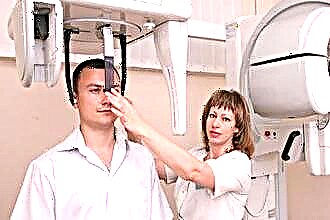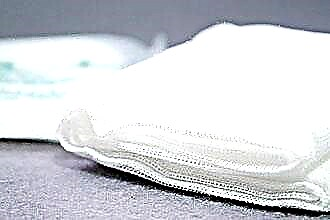Maxillary sinusitis can be treated with various methods. In addition to surgery and taking antibiotics, various physiotherapeutic methods based on folk recipes are widely used. The most common are steam inhalations for sinusitis, which can be easily done at home. Also, inhalations with a nebulizer are becoming more and more popular, which make it possible to more effectively spray the medicine onto the affected tissues.
Advantages and disadvantages of steam inhalation
 Inhalation with sinusitis using hot steam is aimed at warming up the affected accessory pockets and improving the outflow of pathological accumulations. If the manipulation is carried out in compliance with all safety standards, then the patient's condition can significantly improve, in particular, the following positive points are noted:
Inhalation with sinusitis using hot steam is aimed at warming up the affected accessory pockets and improving the outflow of pathological accumulations. If the manipulation is carried out in compliance with all safety standards, then the patient's condition can significantly improve, in particular, the following positive points are noted:
- swelling of soft tissues decreases;
- mucus liquefies and flows out;
- breathing becomes free;
- due to deep heating, blood flows to the sinuses, which improves the body's resistance.
Breathing hot steam is recommended for catarrhal sinusitis, when sinus drainage is possible, although difficult.
Inhalation is also shown for sinusitis at the recovery stage, after the destruction of pathogens and the removal of pus from the sinuses. Often parents ask the question whether it is possible to give inhalation to children at home. Hot steam with biologically active additives is able not only to alleviate the course of the disease, but also to prevent its development if used in a timely manner. However, it is undesirable to carry out any actions without consulting an otolaryngologist when symptoms of maxillary sinusitis appear.
You can not warm up the nose with steam in such cases:
- accumulation of purulent exudate in the accessory chambers;
- high body temperature of the patient (above 38 degrees);
- exacerbation of chronic sinusitis;
- bleeding from the nose;
- breathing problems;
- heart diseases;
- poor health of the patient (weakness, dizziness, nausea).
When using steam inhalation at home, great attention should be paid to compliance with safety precautions, especially when treating children. Do not bend too low over the water, so as not to burn the mucous membranes. There is also a danger of touching the hot edge of the pan or pouring boiling water over yourself.
How are steam inhalations carried out?
The main difference between breathing hot steam is the use of mainly natural products in this procedure, which have a bactericidal, mucolytic, anti-inflammatory, anti-edema effect. Most often, inhalation with sinusitis is done with the following components:
 medicinal herbs in the form of infusions and decoctions;
medicinal herbs in the form of infusions and decoctions;- essential oils;
- beekeeping products (propolis);
- potato.
You can prepare a hot solution and breathe in vapors directly from a kettle or a saucepan, covering your head with a towel, or you can purchase a plastic inhaler with a closed water container and a comfortable physiological attachment for your face at the pharmacy. The second option is preferable from a safety point of view, especially when carrying out the procedure by children.
To achieve the maximum therapeutic effect, it is worth adhering to a number of practical tips for inhaling hot steam:
- sessions are best done in the morning and evening for at least a week;
- the nasal passages must be well cleaned, you can first drip them with vasoconstrictor drops and rinse with saline;
- will enhance the effect of steam and improve the liquefaction of mucous accumulations; drinking plenty of warm herbal teas from plantain, St. John's wort, currant leaves;
- for full warming, you need to inhale with your nose calmly and deeply, and exhale through your mouth;
- for an hour before the session, it is undesirable to smoke and drink alcohol.
When choosing which herbal preparation to use to cure sinusitis, one must not forget that some people have an increased sensitivity to certain components.
In order to avoid trouble, you need to consult a doctor, informing him about all your allergies, and the first procedure should be carried out with extreme caution, observing the body's reaction to the drug.
Common recipes for steam inhalation
Breathing hot steam at home can be based on the recipes of traditional medicine, fortunately, their number is very large. Here are some proven tips that use inexpensive and readily available natural ingredients:
- Bay leaf. A pack of dry leaves is poured with a liter of boiling water and cooked for 5-6 minutes, then removed from the heat, covered with a lid and infused for an hour. After that, you can inhale the vapor, it is advisable to close your eyes to avoid irritation.
- Potato. Several tubers in the peel are boiled until tender, the water is drained, and the potatoes are kneaded a little. You need to breathe for 10-15 minutes.
- Propolis. In a liter of boiling water, pour 2 teaspoons of 10% tincture of an alcoholic beekeeping product. It is recommended to inhale up to 10 minutes three times a day. Inhalation with propolis helps very well at the first signs of a cold, thanks to the bactericidal effect of bee glue, you can prevent the development of a runny nose or acute respiratory infections in maxillary sinusitis.
 Medicinal herbs. Plantain, oak bark, mint, celandine, yarrow, St. John's wort are used for therapy. The classic preparations are chamomile, sage and calendula. Herbs can be applied individually or mixed in different proportions. To prepare the broth, take 2 tablespoons of dry chopped herbs or collection, pour 500 ml of boiling water and cook on fire for 5 minutes. Alcohol tincture of eucalyptus has also proven itself quite well.
Medicinal herbs. Plantain, oak bark, mint, celandine, yarrow, St. John's wort are used for therapy. The classic preparations are chamomile, sage and calendula. Herbs can be applied individually or mixed in different proportions. To prepare the broth, take 2 tablespoons of dry chopped herbs or collection, pour 500 ml of boiling water and cook on fire for 5 minutes. Alcohol tincture of eucalyptus has also proven itself quite well.- Essential oils. 5-6 drops of geranium, pine, eucalyptus, mint, thuja, tea tree or fir essential oil are poured into one liter of boiling water. The procedure is carried out according to the standard scheme.
If during the session the patient did not feel well, then you need to take a break for a couple of minutes, and then continue the procedure. If breathing is difficult, rashes or redness appear on the skin, stop inhaling steam and lie down, if the condition worsens, call a doctor.
With hyperthermia or other contraindications, cold inhalations are sometimes performed. To do this, finely chop a clove of garlic or a small onion and breathe their vapors for 15-20 minutes.
Using a nebulizer to treat sinusitis
With the development of new technologies in the last decade, the practice of doing inhalation for sinusitis at home using a nebulizer has become widespread.
A nebulizer is a device that consists of a medication container, a nebulizer, and a tube with a mask. The medicine poured into the container is transformed into a finely dispersed suspension and delivered exactly to the required area.
There are three main types of nebulizers, depending on their technical characteristics:
- Compressor devices spray liquid using air under pressure, are suitable for all types of medicine, but they are quite noisy in operation.
- Ultrasonics create a suspension using a special membrane. They work silently, but some of the components of the drugs can be destroyed by ultrasound.
- Mesh nebulizers also use ultrasound, but it is produced by a special mesh that preserves all the properties of drugs.
The main advantages of the nebulizer:
- uniform distribution of the drug on the mucous membranes of the nasopharynx;
- the possibility of getting the drug into the sinuses and hard-to-reach places of the nasal cavity;
- preservation of the beneficial properties of the substance used;
- safety and ease of use, incl. children;
- the ability to purchase a finished medicine and not waste time preparing solutions.
Due to the larger area of tissue coverage with the drug, the nebulizer is more effective than nasal drops. It is safer than a pill due to its topical application and, accordingly, fewer side effects. In addition, the drug does not heat up, which prevents it from losing some of its beneficial properties.
It is undesirable to treat sinusitis with a nebulizer in the following conditions:
- cardiovascular failure;
- hyperthermia above 37.5 degrees;
- heart problems (arrhythmia, consequences of a heart attack or stroke);
- pneumothorax;
- bullous emphysema.
The effectiveness of the aerosol is directly dependent on the preparation for spraying. If the tissues in the nasal cavity are swollen, then the particles will not be able to penetrate to the affected areas. If there is mucus in the nose, a significant part of the active substance will not get on the mucous membrane and will soon be removed from the nose along with the snot.
Medicinal solutions used for inhalation with a nebulizer
For spraying, you can use specially prepared preparations in vials (nebulas) with a volume of 5 ml. It is impossible to set the dosage on your own; this decision must be made by the attending physician, taking into account the severity of the disease, the presence of symptoms and the individual characteristics of the patient.
The main groups of prescribed means for inhalation using a nebulizer are as follows:
- Saline solutions moisturize the mucous membranes, prevent them from drying out and normalize the work of the cilia of the ciliated epithelium. You can buy 0.9% saline in a pharmacy or make it yourself by dissolving 2-3 g of table salt in 200 ml of boiled water.
- Alkaline solutions cleanse the epithelium from microbes and impurities, liquefy mucous accumulations, they are good not only for treatment, but also for prevention. Most often they use high-quality medicinal or table mineral water, such as "Narzan", "Borjomi", "Essentuki".
- Antibiotics and antiseptics suppress the activity of viruses and bacteria, prevent their reproduction. Tobramycin, furacilin, dioxidin, fluimucil, miramistin are often used. Bioparox, Isofra and Polydex also confirmed their therapeutic effect.
- Immunomodulators help restore immunity to the body weakened after a course of antibiotics. In such cases, leukocyte interferon or derinat is prescribed.
- Vasoconstrictors help restore nasal breathing. Xylometazoline, oxymetazoline, naphthyzine, naphazoline are used.
- Anti-inflammatory drugs (Chlorophyllipt, Rotokan, alcoholic tinctures of eucalyptus, propolis, calendula).
Today, conventional medicine recognizes steam and aerosol inhalation as a good adjunct to drug therapy. They allow you to reduce the amount of taken oral medications, have a mild effect on the body and help to quickly relieve the patient's condition.

 medicinal herbs in the form of infusions and decoctions;
medicinal herbs in the form of infusions and decoctions; Medicinal herbs. Plantain, oak bark, mint, celandine, yarrow, St. John's wort are used for therapy. The classic preparations are chamomile, sage and calendula. Herbs can be applied individually or mixed in different proportions. To prepare the broth, take 2 tablespoons of dry chopped herbs or collection, pour 500 ml of boiling water and cook on fire for 5 minutes. Alcohol tincture of eucalyptus has also proven itself quite well.
Medicinal herbs. Plantain, oak bark, mint, celandine, yarrow, St. John's wort are used for therapy. The classic preparations are chamomile, sage and calendula. Herbs can be applied individually or mixed in different proportions. To prepare the broth, take 2 tablespoons of dry chopped herbs or collection, pour 500 ml of boiling water and cook on fire for 5 minutes. Alcohol tincture of eucalyptus has also proven itself quite well.

